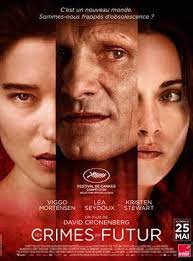
CRIMES OF THE FUTURE
Canada/Greece/UK, 2022, 107 minutes, Colour.
Viggo Mortensen, Lea Seydoux, Scott Speedman, Kristin Stewart, Don McKellar.
Directed by David Cronenberg.
Film buffs will be alert when they see in the name of the director, David Cronenberg, who has also written the screenplay for this film. Cronenberg has been making films for over 40 years, a Canadian, starting with small budget films with such titles as Shivers, Rabid, The Brood, focusing on horror, psychology, bodies. Over the decades he has made a range of films including a version of Stephen King, The Fly, the, bizarrely erotic, Crash, and a kind of alternate universe, Existenz. In 2022, he has returned to some of these early themes.
For audiences not familiar with David Cronenberg, it might be recommended that they go back to some of his earlier films which will prepare them for this one should they wish to venture into it.
The film is set in an extraordinarily dingy future, old wharves, shipwrecks, dark interiors (and somebody noticed, not a computer in sight). The atmosphere is dark in so many ways. And, yet, it is interesting to notice the title, a kind of moral judgement it would seem on the characters and their behaviour.
It should be noted that this is not a film for the squeamish, for those who find the visuals of close-up surgery something that they cannot or do not want to watch. There are many scenes in this vein.
And the characters? The focus is on a reclusive performer, Saul Tenser (Viggo Mortensen who has appeared in several Cronenberg films). He is in pain. To ease the pain and to help him swallow and digest, he sits in a skeletal-looking movable chair. And he is cared for by Caprice (Lea Seydoux), his partner in his performance arts. When Saul gets out of his chair, he is dressed in a black cloak, a black hood, mirroring The Grim Reaper.
And the sequences, and there are many, where he performs our pain-inflicting, with a strange audience of the curious and the photographers, Caprice manipulating surgical knives on Saul’s body, opening him up, extractions… And, there are several similar sequences but, a climax, where a little boy who has been seen at the beginning of the film, then smothered by his mother, promoted by his father (who has a factory manufacturing purple chocolate which has deadly effect), is featured for the audience for an autopsy. Also in the background are two officials of the Registry for Organs and who participate in festivals of such pain performance (Kristen Stewart and Don McKellar).
The film is obviously a parable about human nature, pain, exploitation, mutilation, the picture of an alternate universe – and a challenge to reflect on how much of this future and its crimes are already present in our contemporary world.
- The career of David Cronenberg? Themes, the body, horror, erotic? His career journey? This 21st-century entry?
- The title, the moral judgement about the activities? The body experiments, art, voyeurism, sadism, experiments? The performers? The observers and photographers, audience? The film’s audience?
- The setting, the near future, dingy, narrow, the shipwrecks, the interiors, offices, performance spaces, homes and apartments? The initial openness of the beach and the sea? Leading to darkness? Minimal phones, no computers…? The musical score?
- The tone of the opening, the little boy, his mother, his eating the basket, the foam, lying down, his mother killing him? Her joy? Calling her husband, his hurrying, his grief? And the later focusing on his death, the performance of an autopsy, the mystery what would be found? The father promoting the autopsy? Trying to persuade Saul? The other authorities?
- The introduction to Saul Tenser, his appearance, in the shell -like container, with the strange chair for his movements? His physical state, difficulties in eating, pain? The revelations that he was a performer? Art? Relying on his pain?
- Caprice, her presence, assisting him, her personality, participating in the performance? Supporting him?
- The visuals of the performance, Saul’s body, Caprice and her control, the cutting, the opening, the entrails, the removal of organs? The examination of organs? The observers, the photographers?
- The role of pain in the near future, the role of art and performance? What audiences wanted from such performances?
- The members of the registry for organs, with that, his working with Timlin, ambiguities, authority, the discussions with Saul and Caprice? Approval? Disapproval? The organisation of the pageants, the awards? The ambiguous meetings with Saul, Timlin, her personality, her voice and utterance, her attitude towards Saul, advances on him?
- The character of Cope, the meetings, in the dark, his admiration for Saul, his authority, the discussions about the autopsy?
- Lang, preparing the chocolate, his factory, the man eating the chocolate and dying? His response to his son’s death? To his wife? The idea of the autopsy? The approach to Saul and? The discussions, the motivations?
- The performance of the autopsy, the audience, the incisions, opening, the entrails, the messages? For whom? Lang and his reaction?
- The two women at the factory, stripping, wanting to become involved in performance? Their observing the autopsy? Their weapons, the killing of Lang?
- Caprice, her care for Saul, the strength of the relationship, entrepreneur with the performances, the discussions with the officials for organ registration? Meeting up with other interested performers, the woman, and the mutilation of her forehead? Yet her persevering, the autopsy?
- The ultimate effect on Saul, the art, the performances, his health, unable to eat, wanting to die, Caprice offered him the chocolate? His death?
- The effect for an audience of immersion in this future/alternate, pain-oriented, voyeuristic, pessimistic world?